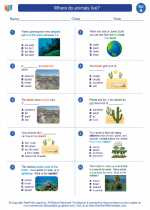Where do animals live?
Animals live in a variety of habitats that provide them with the necessary resources for survival. These habitats can be classified into different types such as forests, grasslands, deserts, mountains, oceans, and polar regions.
Forests
Forests are home to a diverse range of animals including bears, deer, squirrels, and birds. The dense vegetation provides shelter and the abundance of plants supports a variety of herbivores and omnivores.
Grasslands
Grasslands are characterized by vast open spaces and are inhabited by animals such as zebras, lions, elephants, and various species of birds. The grass provides food for herbivores, which in turn support carnivores and omnivores.
Deserts
Deserts are harsh environments with limited water and extreme temperatures. Animals such as camels, snakes, and lizards have adapted to survive in these conditions by conserving water and seeking shelter from the intense heat.
Mountains
Mountainous regions are home to animals such as goats, snow leopards, and eagles. These animals have adapted to the rugged terrain and harsh climate, using their agility and specialized features to thrive in this environment.
Oceans
Oceans cover the majority of the Earth's surface and are home to countless marine animals including fish, whales, dolphins, and various forms of marine life. The diversity of ocean habitats, from coral reefs to deep sea trenches, supports a wide range of species.
Polar Regions
The polar regions, including the Arctic and Antarctic, are inhabited by animals such as polar bears, penguins, seals, and Arctic foxes. These animals have adapted to the extreme cold and rely on the surrounding ice and water for their survival.
Study Guide
- What are the different types of habitats where animals live?
- Give examples of animals that live in forests, grasslands, deserts, mountains, oceans, and polar regions.
- How do animals adapt to survive in their specific habitats?
- Why is it important to protect and conserve these habitats for animals?
◂Science Worksheets and Study Guides First Grade. Where do animals live?

 Activity Lesson
Activity Lesson
 Worksheet/Answer key
Worksheet/Answer key
 Worksheet/Answer key
Worksheet/Answer key
 Worksheet/Answer key
Worksheet/Answer key
 Vocabulary/Answer key
Vocabulary/Answer key
